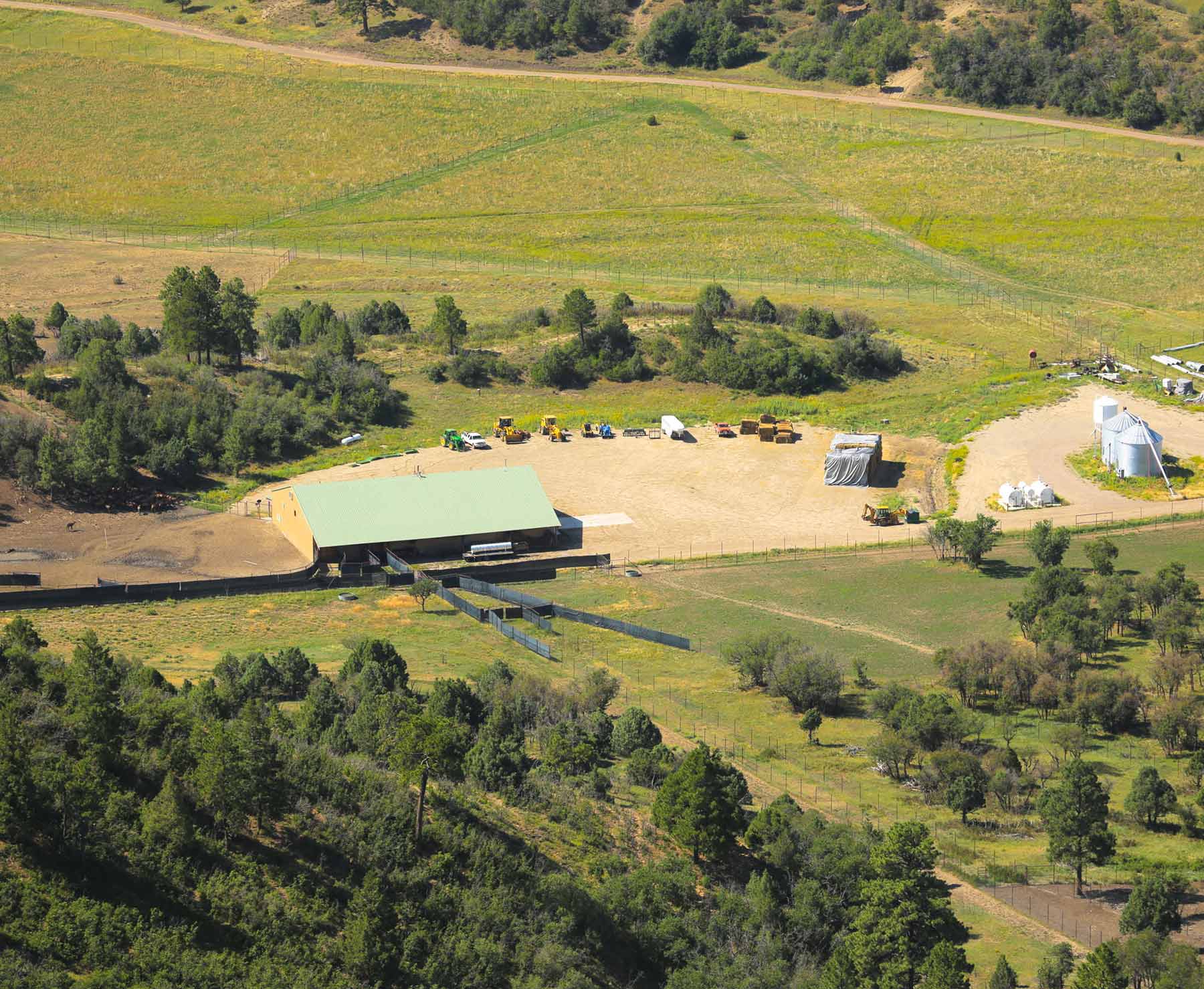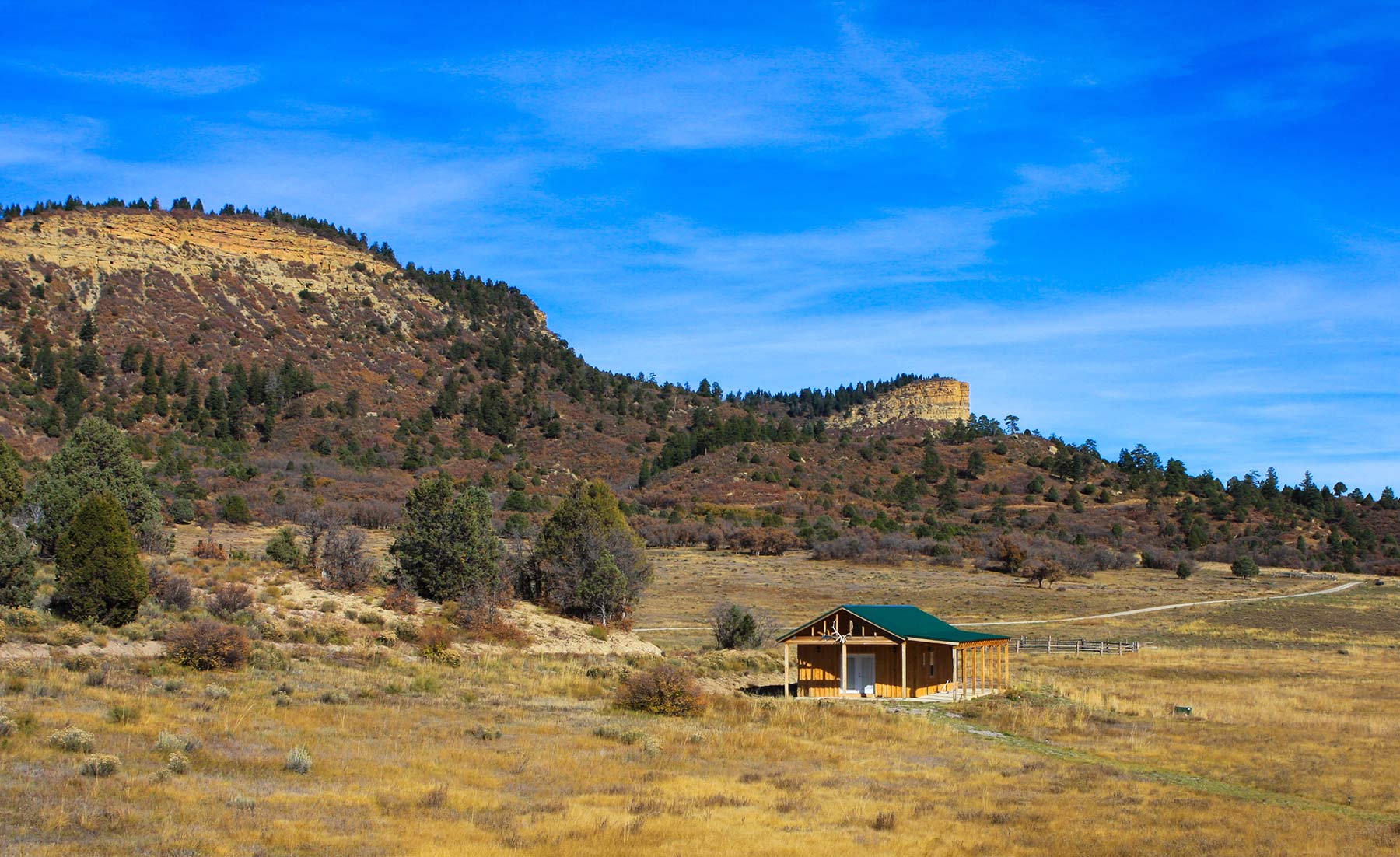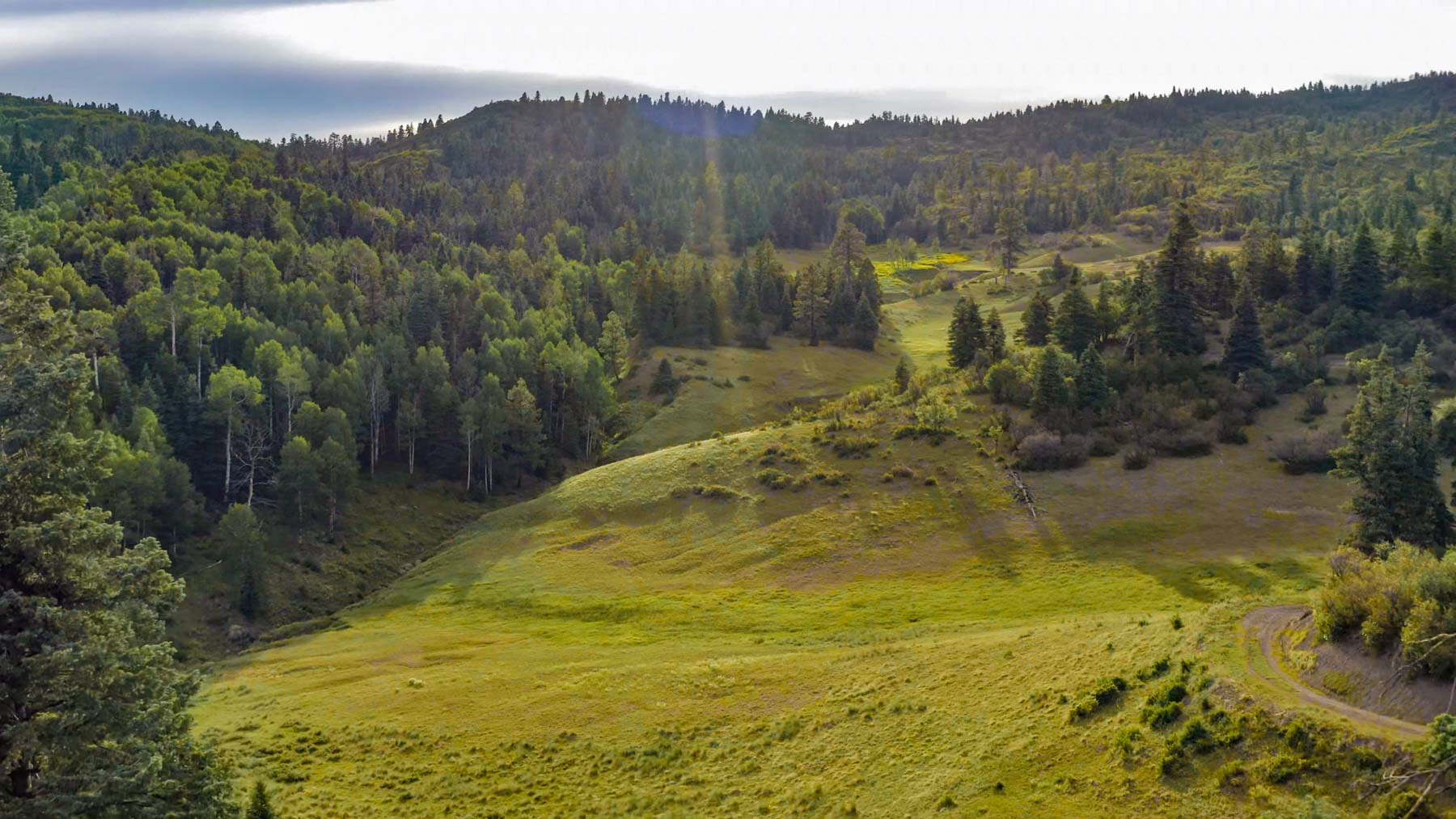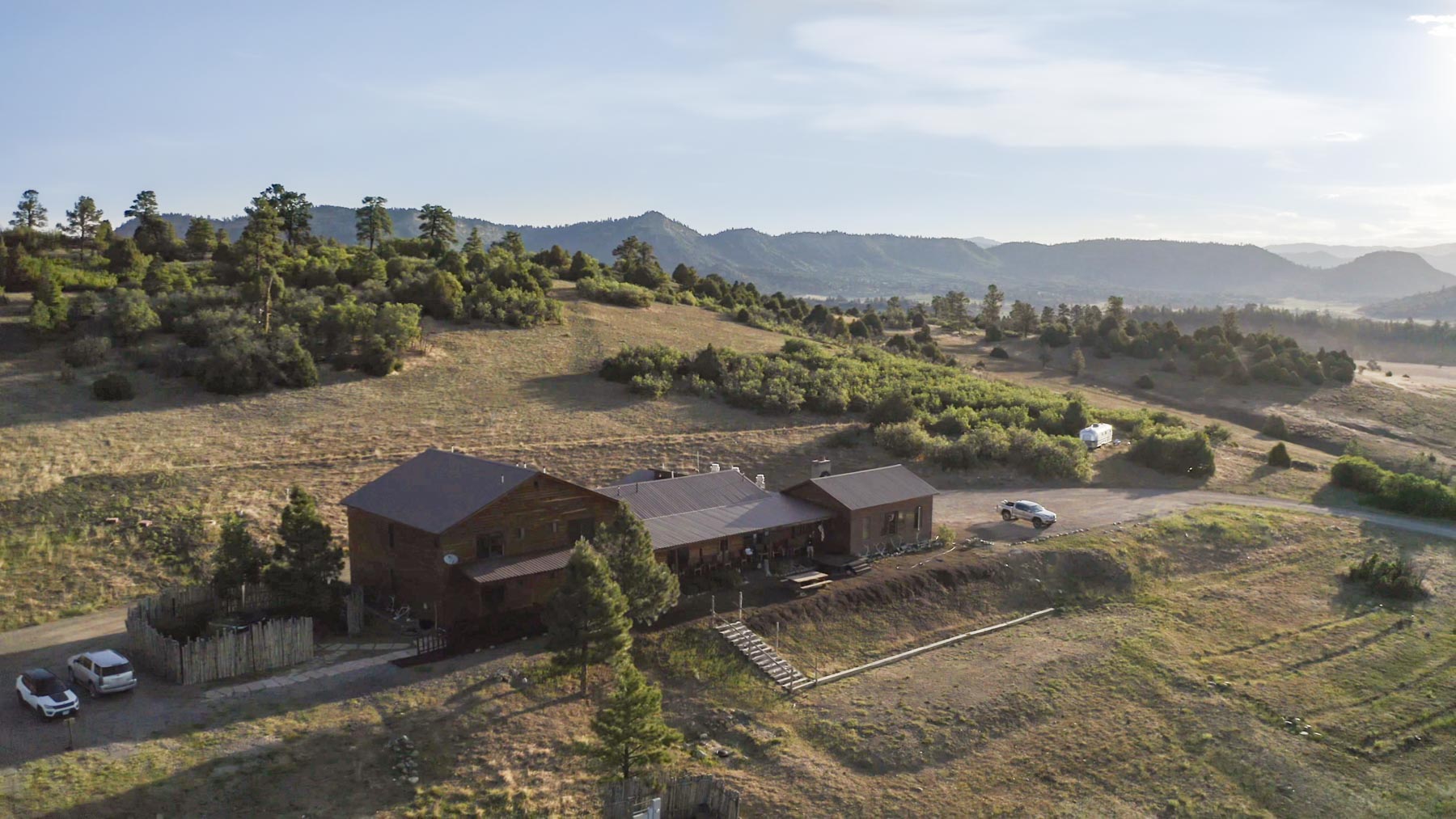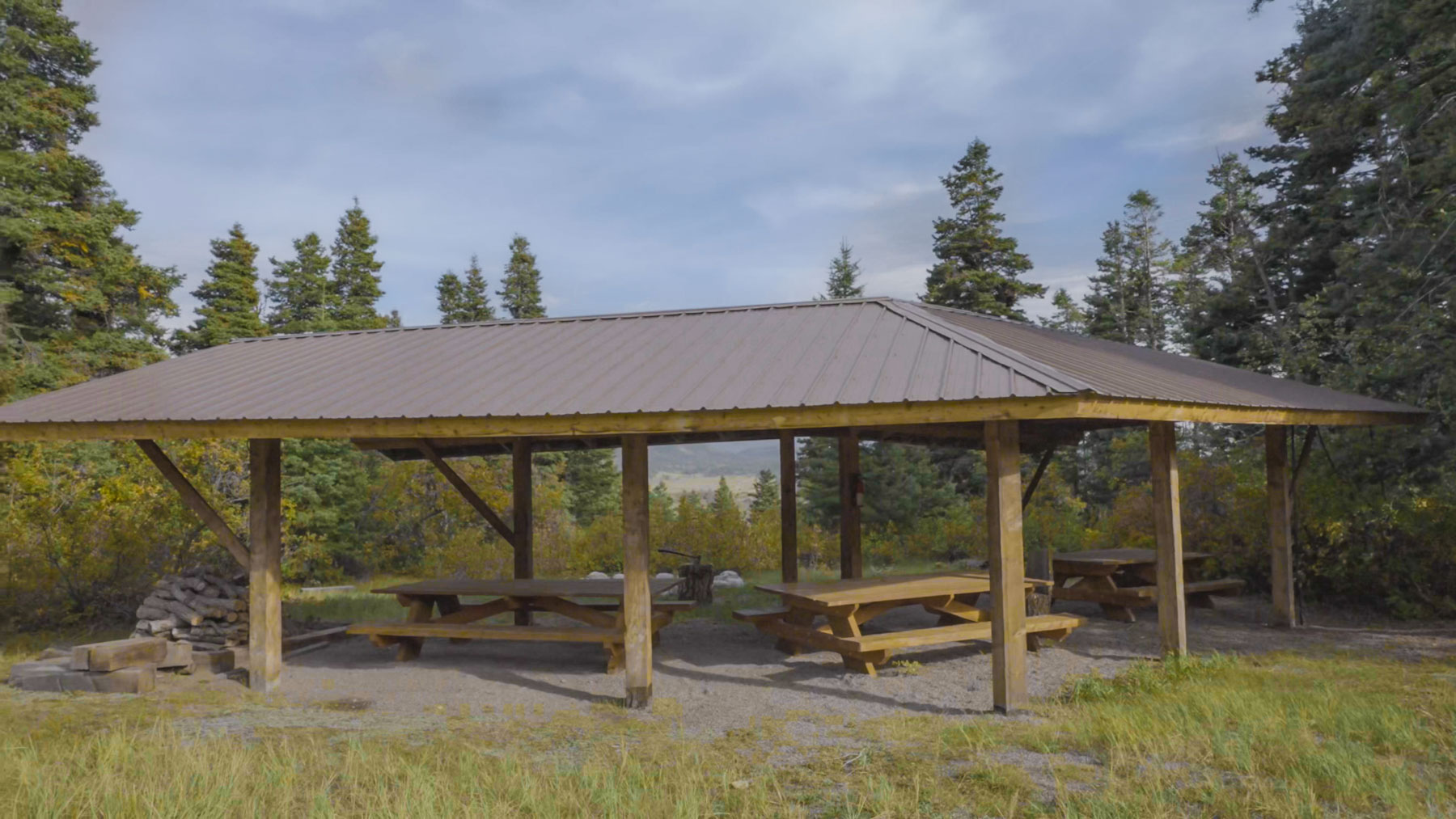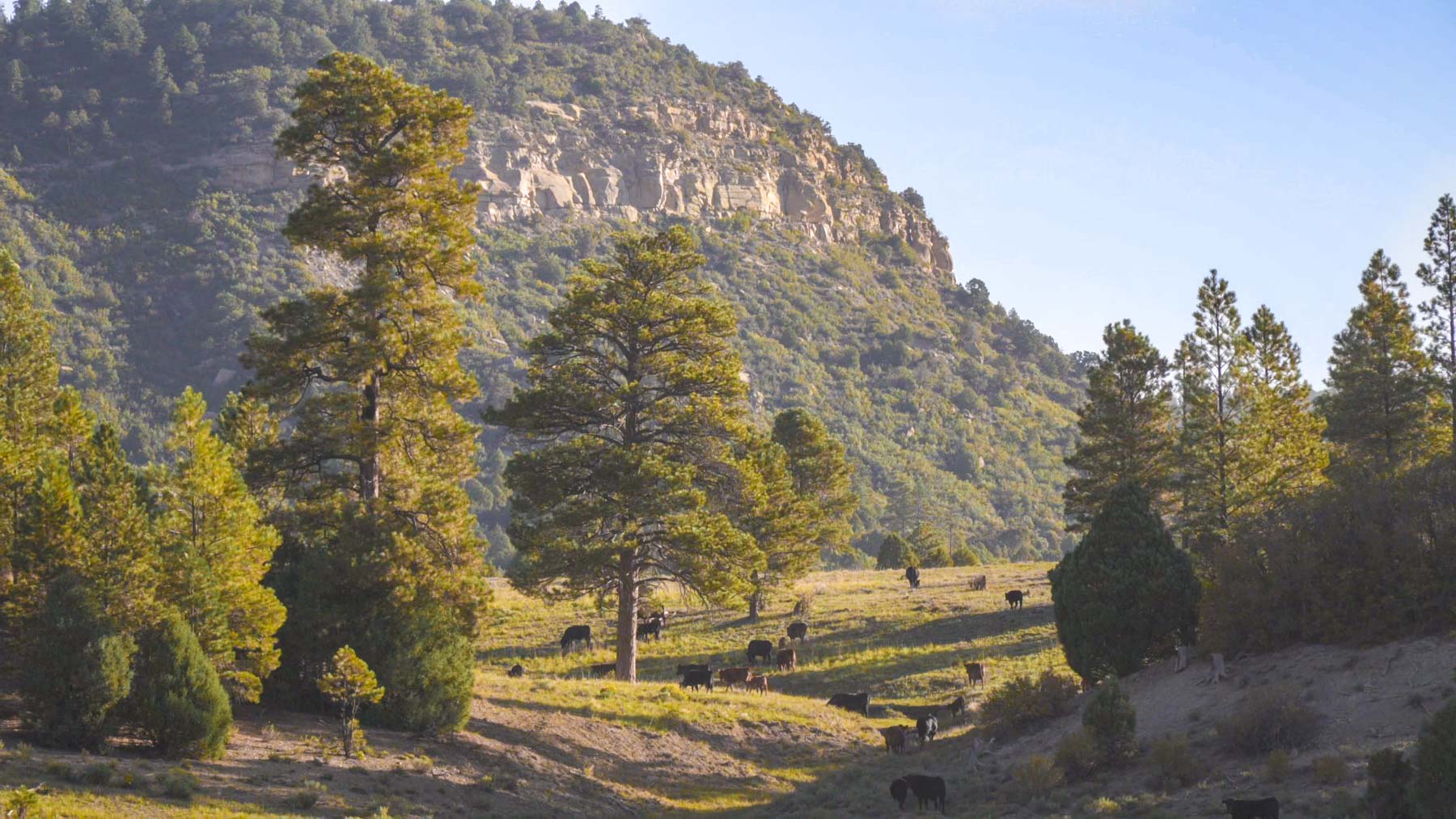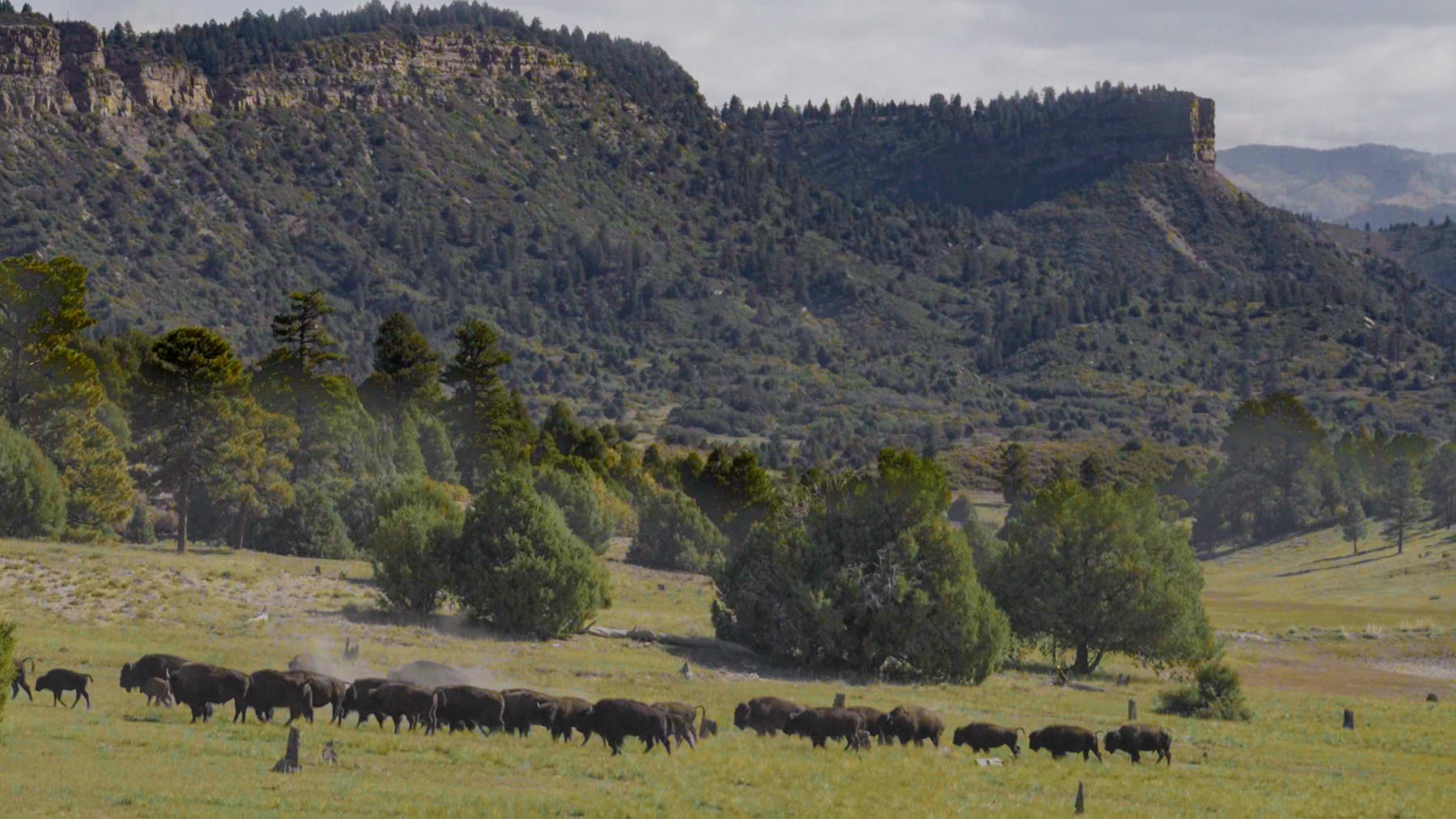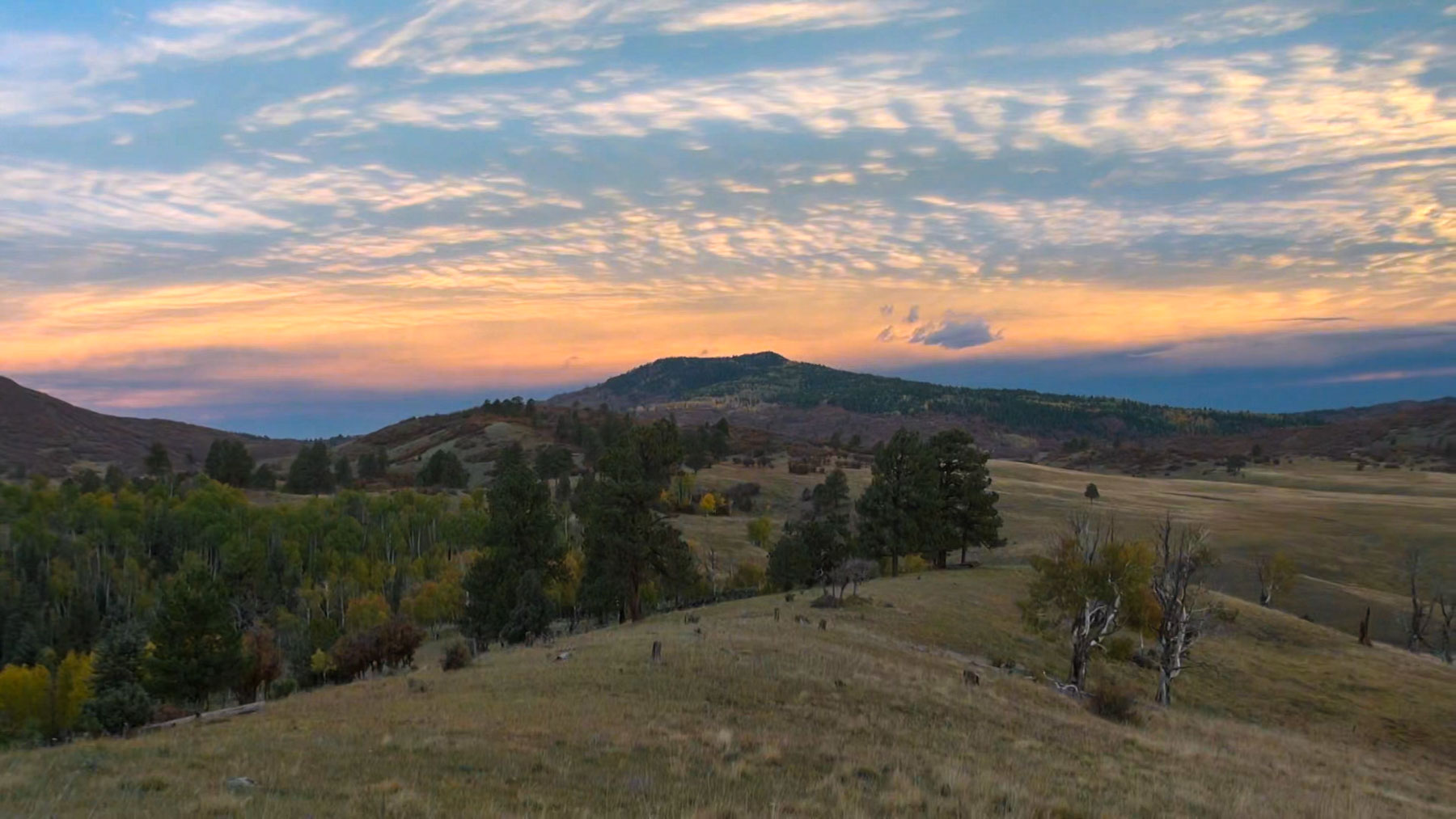Overview
Executive Summary
The 16,706± deeded acre Quinlan Ranch is a superlative mountain hunting property located just three miles west of Chama, New Mexico. The Quinlan, as it is known, spans over 26 square miles in a single block of contiguous land with no private inholdings or public roads across it. Offering an unequaled combination of size, privacy, accessibility, and scenery, the Quinlan controls the entire eastern slope of the 9,900 foot Chromo Mountain and is comprised of ecologically diverse and rich mountain and valley floor terrain. This large holding features outstanding big game hunting, expansive vistas, fishing, limitless recreational activities, and numerous water resources that are complimented by excellent infrastructure and quality accommodations.
Thoughtful habitat and wildlife management ensures that the Quinlan is home to significant populations of resident elk, mule deer, black bear and turkey. Distinguishing the Quinlan from other western hunting properties is the fact that an estimated 6,000 to 8,000 head of elk from the San Juan Elk Herd migrate through the Quinlan and the neighboring 20,000 acre elk preserve – the Edward Sargent Wildlife Area, each fall. Ownership, family, friends, and clients can easily hunt the Quinlan as it currently receives 63 rifle bull elk permits, 24 bull elk archery permits and 29 cow elk permits from the New Mexico Department of Game and Fish. Numerous trophy elk and mule deer are taken here every year and the ranch has been featured on many outdoor pursuit television shows. Additional trophy and management elk hunting opportunities exist within the on-site Rim Rock Elk Park which is a licensed 2,000± acre high-fenced Class A Game Park. Currently, the Game Park includes approximately 90 adult bulls, 85 cows, 10 yearling females, 7 yearling males, 21 female calves and 23 male calves.
Well suited for both private and commercial use, the Quinlan has year-round access off of US Highway 84. Improvements include the 6,678± square foot Garcia Lodge, two “glamping” bathhouses and covered cooking and eating areas, a 10,000± square foot barn with sleeping quarters, office, garage, and state-of-the-art elk handling facilities, as well as several paddock areas for privately owned elk. The ranch also boasts an exceptional internal road network with over 65 miles of private roads, buried water and electrical lines, as well as approximately 40 ponds – several of which are stocked with trout. The listing price includes 50 percent of the appurtenant mineral rights*, all privately owned elk, and an extensive inventory of essential ranch equipment and rolling stock (See Quinlan Ranch Inventory).
*Seller believes, but will not warrant, that it owns 50 percent of the appurtenant subsurface mineral rights which will convey with the sale. Buyers are encouraged to retain legal counsel for the purposes of confirming mineral rights ownership.
General Description
Traveling west on US Highway 84 just three miles from Chama, New Mexico, one’s first glimpse of the Quinlan Ranch is of its lower elevation southern boundary and the Willow Creek drainage. This open valley sits at an elevation of just over 7,700 feet and rises in elevation to the north and west into rolling hills, ridges, and draws interspersed with open parks and stands of ponderosa pine and mountain oak. Following Willow Creek to the north, one encounters a series of large trout ponds, and a 100-acre food plot. To the east of Willow Creek is the Rim Rock Elk Park breeding pens, elk handling and facilities buildings, and the southern fence line of Rim Rock Elk Park. To the west of Willow Creek is the “Garcia” portion of the ranch which includes the aforementioned food plot and a side valley that is home to the horse camp, complete with a bathhouse, large-group dining shelter, as well as “glamping” sites. Comprised of rolling hills, the Garcia is a blend of open parks and large stands of oak with intermittent ponderosa and juniper trees. Situated at the southern end of the Garcia is the aptly named Garcia Lodge. Built for the purpose of housing and entertaining guests, the lodge is conveniently accessed from the highway. Set on a hillside overlooking the Chama Valley, Garcia Lodge sits in a location where it will not impact wildlife.
Effectively separating the lower and southern portion of the ranch from the upper mountain country are a series of broad slopes and rimrock capped buttes that juts out dramatically above the landscape. Separated by a series of canyons and smaller drainages, these buttes top out at over 8,700 feet. From their respective summits, one can enjoy expansive views of the valley floor below. The easternmost buttes on the ranch are contained within the Rim Rock Elk Park. The game park runs along a portion of the eastern boundary of the ranch and is comprised largely of steeply timbered slopes that give way to benches and open meadows at the lower elevations.
To the north and behind the buttes is the center of the ranch. Accessed by a number of internal roads, this portion of the ranch is defined by broad basins with large trout ponds and grass-laden meadows. The basins are intersected by a series of ridges and are ringed on all sides by mountain slopes covered with aspen groves, pine, and oak forests. Willow Creek winds down from its headwater at the north end of the ranch through one of the broad valleys here before dropping into a canyon and down to the southern end of the property. Water resources are numerous with a number of ponds scattered throughout the various drainages and small creeks feeding down from higher elevations. These open meadows and water sources are heavily utilized by the wildlife that bed among the surrounding ridges and mountain slopes.
Elevations along the basin floors begin at around 8,100 feet and rise to the east to over 8,700 feet along the summit of the long ridge that serves as the eastern border of the property. From the top of this ridge one can survey the ranch’s undulating interior reaches back to the west and north and look down to the east upon the neighboring Edward Sargent Wildlife Area. Elevations climb more gradually to the west and top out at over 8,600 feet along a series of knobs along the western boundary line which is the North American Continental Divide.
From the center of the ranch, elevations ascend to the north, with the terrain becoming more mountainous in nature and forested with large stands of aspen, spruce, and fir. Anchoring the northwestern end of the ranch is 9,900 foot Chromo Mountain. The Quinlan controls the entire eastern slope of this mountain which is heavily timbered and serves as a sanctuary for large numbers of elk. The High Camp is also located here and provides guests with a high-country destination from which they can relax and enjoy a meal or even a hot shower. Strategically located ponds and an eight-acre trout lake sit at the base of Chromo Mountain – all of which draw wildlife out of the timbered mountainside. A series of forested ridges separated by drainages with open valley floors define the northern end of the ranch. The origination point for Willow Creek is also located here and sits just within the property boundary.
The Edward Sargent Wildlife Area is the neighbor to the north and east. Large, privately held ranches are the neighbors to the west and northwest. From the higher points of the upper or northern portion of the ranch, one can survey miles of the Quinlan Ranch to the south, or look north to Chama Peak and the San Juan Mountains.
Broker's Comments
The Quinlan Ranch is a place where the timbered mountain slopes of the Southern Rockies meet the mesas, buttes, and dramatic cloudscapes of the American Southwest. Imbued with beauty, the Quinlan’s productive lands have become a gathering place where lifelong friendships are created, experiences are shared, and lasting memories are made.
Well-suited for both private and commercial use, the Quinlan represents an opportunity to acquire 16,706± acres of gorgeous mountain property with unmatched privacy and big game hunting. The ranch has excellent access and is minutes from the historic mountain community of Chama and just south of the amenities, skiing, and FBO in Pagosa Springs, Colorado. Recognizing the potential these lands held, the Peters family purchased the property and began transforming it into a top of the list ranch and recreational destination. This transformation included years of professional wildlife, habitat and water resource enhancement, the procurement of neighboring lands, as well as the securing of valuable water and mineral rights. Combined with quality improvement and infrastructure development, the Quinlan Ranch now offers something for everyone and can be easily acquired and enjoyed by new ownership for years to come.
The Quinlan Ranch, with all of its amenities is priced on essentially a turn-key basis at $44,000,000, or $2,633 per acre. This package includes all permanent improvements, all minerals, license to use the Quinlan Ranch name, all elk located within the Rim Rock Game Park, along with an extensive inventory of equipment/rolling stock.
Locale
Location
Situated in the mountainous country of the upper Chama Valley in northern Rio Arriba County, New Mexico, the Quinlan Ranch lies less than half a mile from the Colorado state line and just three miles west of the historic community of Chama. The western boundary of the majority of the ranch straddles the Continental Divide. The property is adjacent to the Edward Sargent Wildlife Management Area and a short drive from the Carson and Rio Grande National Forests as well as the Jicarilla Apache Nation Reservation and Bill Humphries Wildlife Management Area.
Driving time to Pagosa Springs, Colorado and the Stevens Field FBO is 45 minutes from the ranch headquarters. The Stevens Field Airport offers an 8,100 x 100 foot runway capable of landing larger private aircraft as well as new FBO facilities offering a full range of services and amenities. The Wolf Creek Ski Area is located just a few minutes outside of Pagosa Springs and is easily accessible from the ranch. Durango, Colorado and commercial air service at the Durango-La Plata County Airport is a two-hour drive from the ranch. Santa Fe and Taos, the arts and cultural meccas of the Southwest, are each less than two hours to the south and east, respectively. Albuquerque and the Albuquerque International Sunport/ airport are a three-hour drive to the south.
Locale
The Chama Valley of northern New Mexico straddles the Rio Chama or Chama River and serves as a transition zone between the high peaks of the San Juan Mountain Range and the painted cliffs and bluffs of the lower elevation San Juan Basin. Located at an elevation of 7,800 feet, the valley floor is lined with lush meadows, willows, and ancient cottonwood stands. Elevations rise to the north and east with the 12,021 foot Chama Peak anchoring the northern head of the valley. The eastern backdrop of the valley is the San Juan Mountain Range with many peaks and mountain tops rising to elevations in excess of 10,000 feet. The valley opens to the San Juan Basin to the west.
Relatively undiscovered, the Chama Valley is controlled by large private holdings and expansive tracts of state and federal lands. The general aesthetic is more in line with the mountainous regions of southern Colorado. Here, views are dominated by the snow-capped peaks, aspen and pine forests, and giant ponderosas that rise dramatically above the river bottom. From its headwaters just a few miles to the north in Colorado, the trout-laden Rio Chama flows through the community of Chama and continues south for nearly 130 miles to its eventual confluence with the Rio Grande.
The nearby community of Chama, New Mexico, sits near the head of the Chama Valley and just south of the Colorado state line. An historic 1880s railroad town, Chama has long enjoyed a strong ranching and agricultural-based culture. Thanks to its mountain location and limitless recreation opportunities, the community has quietly gained notoriety as a four-season mountain destination. In addition to exceptional angling and hunting, Chama also provides hiking, trail rides, snowmobiling, proximity to excellent skiing at the Wolf Creek Ski Area and Taos Ski Valley. Chama is the home to the Cumbres & Toltec narrow-gauge railroad. The Cumbres & Toltec’s historic coal-fired steam engine provides scenic train rides through the mountains of northern New Mexico and southern Colorado. In addition to the year-round activities, Chama and the greater Chama Valley have become a place where hunters arrive from around the world to pursue trophy elk and mule deer in what is arguably some of the best game habitat imaginable.
Climate
Located at an elevation of 7,800± feet and receiving an average of 300 days of sunshine, Chama enjoys a favorable year-round climate. Summertime temperatures reach into the high 70’s and the mid 80’s, while average daytime winter temperatures typically range between the 30’s to mid 40’s. Boasting a remarkable year-round climate, the average snowfall is nearly 100 inches, with annual precipitation over 20 inches.
History
The Quinlan Ranch has been under only two ownerships since 1912 when the property was purchased and operated by Ed Sargent and later, his heirs, the Quinlan Family. A pioneering rancher in northern New Mexico, Mr. Sargent accumulated tens of thousands of acres of ideal mountain property in the region which he and his family members ranched for decades. The neighboring Edward Sargent Wildlife Area which borders the Quinlan to the east for over eight miles and was also previously owned by Mr. Sargent, is named after him. The Peters family from Santa Fe acquired the 12,000± deeded acre Quinlan Ranch from the Quinlan family in 2005. In 2007, the Peters family added over 4,000 additional acres to this holding through the acquisitions of the adjacent Garcia Ranch. The addition of the Garcia Ranch increased the size of the Quinlan 16,706± deeded acres.
Property Details
Acreage (Deeded & Leased)
Deeded Acres: 16,706±
Total Leased Acres: 0±
Total Acres: 16,706±
Additional Information
To further preserve and protect wildlife habitat, the Quinlan Ranch granted a conservation easement on a small portion of the ranch to the Rocky Mountain Elk Foundation in 1998. This easement is limited to 900 acres of mountainous land located in the extreme north end of the ranch. Under the terms of the easement, the ranch retains the right to hunt these 900 acres, but agrees to preserve and protect them for the natural habitat and continued ecological benefit of New Mexico wildlife. Upon request, a copy of this conservation easement will be furnished. The balance of the ranch is not encumbered by any conservation easements.
Improvements
When the Peters family acquired the Quinlan Ranch it was a traditional livestock property with the only improvements being a tin-tack structure, a few horse pens, as well as a 1,500-acre game park that was lacking trophy genetics. There was some fencing in place, but no electricity, no water development or wells, no facilities for employees or guests, and no fishing. Internal roads were limited and those in the northern portion of the ranch were so impassable that all hunting was conducted on horseback. With quality habitat enhancement and thoughtful improvement and infrastructure development, the Peters family has molded the property into a destination sporting property – all while preserving the ranch’s native environment.
GARCIA LODGE
Conveniently located on a hillside overlooking the Chama Valley is the 6,678± square foot Garcia Lodge. This two-story lodge features 11 bedrooms and 12 bathrooms, a commercial kitchen and large dining area, as well as the ranch’s gathering place, a grand room with a river rock fireplace. Well-suited as a commercial or corporate lodge or personal retreat, Garcia Lodge is comfortably furnished and easily accessed off of Highway 64.
HORSE CAMP
The horse camp is tucked into a private valley to the east of Willow Creek in the southern end of the ranch. Primarily utilized during the ranch’s large trail riding events, the camp includes “glamping” sites, a large kitchen shelter with a hot water sink and grills as well as a dining shelter. Complete with propane lighting and views of the ranch’s rimrock outcroppings, the dining shelter accommodates over 70 guests. The third primary structure at the horse camp is a large bathhouse with a large storage area, four toilets, six showers and four sinks with hot water provided by two on-demand water heaters.
HIGH CAMP
Utilized as a destination for trail rides and rest and relief area for anglers and hunters in the northern reaches of the ranch, the high camp features a large shelter structure, water catchment system with storage tanks, as well as a bathhouse with a tub, showers and sinks with hot water, as well as toilets.
FACILITIES BARN
Sited in the southeastern corner of the property is the 10,000± square foot barn that serves as the base of ranch operations for the Quinlan. In addition to containing offices, the barn has living quarters with five bedrooms, three bathrooms, and a kitchen capable of housing a 12-member guide team. Included in the shop is a large garage or repair shop with a gantry, truck lift, and a walk-in cooler for game. The elk handling facility for the private elk herd is also housed within the barn. A series of handling pens, alleys, and a hydraulic chute with an overhead gangway ensures safe and easy handling of private elk for both herd health maintenance and artificial insemination purposes. A fenced alleyway links the barn to numerous paddock areas which are utilized by trophy breeder bull elk and cow elk. The barnyard has two large grain bins for the storage of alfalfa pellets as well as an additional elevated bin for Antler Max supplemental feed. Two double-walled 5,000 gallon tanks in the barnyard are used to provide fuel to hunting vehicles and heavy equipment.
INFRASTRUCTURE
In addition to constructing the improvements needed to sustain their operations, the Peters family has continually improved the Quinlan Ranch’s infrastructure. One of the first projects the family undertook was to open access up to the ranch by rebuilding the internal road system. Investing in a road grader and bulldozer, the family turned nearly impassible two-track jeep roads into nearly 65 miles of quality ranch roads. Road base materials have been placed on the most heavily traveled roads and two semi loads worth of culverts were put in place to divert runoff drainage. Along with the private road system, seven miles of buried power lines, as well as 15 miles of water lines, were installed. A well was also put in place as was a water collection system along Willow Creek that pumps water into two 10,000-gallon storage tanks with a radio controlled float system. This water system feeds over 50 water spigots that supply water to the barn, horse pens, elk pens, bathhouse, horse camp kitchen and potential future cabin sites. A solar powered radio system was also installed to ensure guides and staff can communicate from every corner of the property.
In 2008 the Peters family initiated a multi-year water catchment and water feature improvement project. Signature lakes including the Honeymoon and Willow Creek Lakes as well as a number of stock ponds were first reconstructed. New stock ponds were constructed, and in each of the last ten years, additional fishing lakes were built or deepened in order to improve trout habitat. The ranch retained the services of Joe Urbani and Urbani Fisheries, LLC, a leading provider of aquatic habitat enhancement and stream, river, and lake reconstruction out of Bozeman, Montana to oversee and improve its trout habitat and development work. With Mr. Urbani’s oversight, the ranch added aquatic benches and agri drains to existing trout ponds. Aquatic bug and plant life quality were enhanced and the ranch now provides excellent still water trout fishing on a number of bodies of private water. These significant hydrological projects greatly benefitted wildlife, opened the door to an angling clientele base, and reshaped the ranch’s aesthetic look and feel.
An eight-foot-high game fence contains the 2,000-acre Rim Rock Elk Park which is located in the very rugged and mountainous terrain in the southeastern portion of the ranch. The park has been improved through a series of projects including removal of underbrush, logging of key areas identified by a forester, extensive reseeding of grasses, and additional roads through and around the park perimeter.
Wildlife habitat improvement practices continue to be implemented on the ranch. Along with a noxious weed control program, the ranch utilizes forestry management practices with logging conducted in key wildlife crossing corridors and other areas identified by a forestry consultant, as well as remediation of logging sites left from the prior owners. In addition to the forestry work, the ranch has tilled and seeded areas of the ranch that were previously overgrazed by cattle. These food plots, including a 100-acre food plot located on the west bank of lower Willow Creek, are now well-utilized by wildlife.
Water Resources
Willow Creek and its numerous tributaries are the primary sources of water for the property. During their tenure, the Peters family has extensively engineered, constructed, and improved the ranch’s water resources. The acquisition and transfer of additional valuable water rights to the ranch has greatly benefited all manner of animal life. These water rights have also allowed the ranch to irrigate food plots and build and fill a total of eight stocked trout ponds ranging in size from just over one acre to over eight acres in size. There are several springs located throughout the property as well as over 30 earthen ponds that hold water for wildlife and cattle. Domestic water is provided by three wells that have been developed to provide water for this purpose. New ownership will realize the benefits of the valuable water rights and development for decades to come.
Mineral Rights
The Peters family recognized the importance of mineral rights ownership and has acquired mineral rights that had been previously severed from the land. A new owner will realize the benefits of these efforts both in terms of the potential future monetary value of those rights, as well as for the purpose of controlling future decisions related to land stewardship. The Seller believes, but will not warrant, that it owns 50 percent of the appurtenant subsurface mineral rights which will convey with the sale. Buyers are encouraged to retain legal counsel for the purposes of confirming mineral rights ownership.
Taxes
Property taxes on the Quinlan Ranch are extremely reasonable, being approximately $8,899 per year, or approximately 52¢ per acre.
Recreational Amenities
Fishery Resources
A total of seven impoundments on the ranch have been stocked with brown, rainbow, and cutthroat trout. Professionally designed habitat within these fisheries promotes healthy aquatic plant life and trout populations that produce trout in the two to five-plus pound range. Fly fishing and spin fishing are excellent in these catch and release only waters and as a result, the ranch now has a loyal following of sportsmen and women who visit the Quinlan for the sole purpose of angling. Having the trout impoundments located throughout the ranch provides anglers with a diverse set of angling locations and opportunity. Fishing from the banks as well as the ranch’s fleet of ClackaCraft drift boats is enjoyed by anglers of all skill levels. The ranch’s fly fishing guides also have access to additional private water on the nearby Chama River as well as other private fisheries.
Wildlife Resources
New Mexico’s Game Management Unit (GMU) 4 is highly regarded as a trophy elk and mule deer unit. In addition to large populations of resident elk and mule deer, the entirety of GMU 4 serves as a massive migration corridor and wintering range for elk migrating south from the San Juan Mountains in Colorado. The unit is comprised nearly entirely of private land and borders the famed Jicarilla Apache Nation – which is arguably the top trophy mule deer destination in North America. With the exception of some areas of BLM lands, the vast majority of public lands found within GMU 4 are comprised of the Sargent, Humphries, and Rio Chama Wildlife Management Areas. Public land hunting licenses and access within GMU 4 are restricted to these Wildlife Management Areas. These licenses are very limited in number and only available to the public through the regular license application process. The Quinlan is located within GMU 4 and shares its eastern boundary with the Sargent Wildlife Management area for nearly eight miles. The “Sargent”, as it is known, is a non-motorized use area that is widely regarded for excellent elk hunting. Managed as its own game unit within the greater Unit 4, the Sargent is one of the few hunting units in New Mexico to receive a “Quality” designation from the Game and Fish Department. As such, hunting licenses for this neighboring property are highly sought after and difficult to obtain.
The Quinlan’s location in the north central portion of GMU 4 places it in a literal sweet spot between high country summer habitat to the north and lower elevation wintering grounds to the south. Not only does the ranch lay in the path of thousands of migrating elk each fall, its favorable elevation and habitat ensure it is home to a large population of resident elk throughout the year. Because of quality land management, sound hunting practices, and the development of its food plots, the Quinlan is now retaining a higher number of the migratory elk throughout the hunting seasons that would have otherwise passed through the ranch. In addition to the elk, serious mule deer hunters will recognize that the ranch’s location in Rio Arriba County places it in one of the top trophy mule deer locales in North America. Mule deer drop their fawns on the property each spring and numerous bands of bucks and does reside on it until the snows in late November push them to their wintering range just a few miles to the south. Strong populations of Merriam’s turkey as well as healthy numbers of black bear and some mountain lions reside in and are hunted on the Quinlan. In addition to the big game, the ranch provides vital habitat for a wide range of wildlife.
Mule deer populations are strong and the Quinlan Ranch has a demonstrated track record of producing trophy mule deer. With the exception of the occasional management deer, the smaller bucks harvested score between 170” and 185”. Deer scoring between 185” and 195” are taken each year and bucks up to 220” have been taken in recent years. Success rates on deer hunts are nearly 100 percent.
General Operations
General Operations
HUNTING OPERATIONS
The Quinlan Ranch stands alone as a property with a large-scale commercial hunting operation that provides high rates of success for trophy elk – year in and year out. The ranch also offers excellent hunts for trophy mule deer, black bear, mountain lion, as well as spring turkey. As a result of its location, land stewardship practices, professional staff, facilities, and quality game management, the Quinlan has become a top destination for hunters across the globe as well as a popular filming destination for a number of outdoor pursuit television shows. Indicative of the ranch’s rise to prominence in the upper echelons of the hunting world are the facts that the ranch can command a premium price for its hunts and that the hunts are booked well in advance of the hunting seasons. The ranch sells and conducts over 80 guided wild bull elk hunts each year. The following page has current pricing for various hunting and fishing packages. Contributing greatly to the success of the Quinlan’s hunting program is a professional and knowledgeable hospitality and guide staff. Both the hospitality and guide staff have been working on the ranch for years and their collective and individual knowledge of the operations, terrain, and wildlife is unmatched.
Additional preserve elk hunts are also available within the ranch’s 2,000-acre Rim Rock Elk Park which is a Class A Game Park. This park or hunting preserve provides hunters with the ability to choose their own hunting dates and harvest trophy elk scoring up to and in excess of 450” SCI. Though the park is a destination hunt for some, it also provides hunters who have filled their wild elk tags with the opportunity to purchase and take a second elk during their stay. Hunters also have the opportunity to harvest bison while on the Quinlan. Ownership has invested significant resources into developing the genetics and health of their private elk herd to the point that Rim Rock Elk Park now possesses arguably the finest trophy quality of any game park in New Mexico. In addition to implementing an artificial insemination (AI) program, the ranch utilizes trophy bull elk as back-up breeders to ensure high conception rates. Further bolstering of genetics and trophy quality came through acquisitions of elk from certified elk breeders. Elk originating from a herd in Oregon as well as three loads of cow elk and trophy bulls with an average SCI score of 450” from Canada were brought to the ranch. The largest bull killed in the park scored 497 inches. The ranch typically conducts between 15 to 20 trophy elk hunts a year in the park in addition to a number of management bull elk and cow hunts as needed. Bison are a relatively new addition to the hunting options and a growing number of these hunts are being sold.
ANGLING OPERATIONS
The Quinlan and the Chama area in general are quietly emerging as a fly fishing destination for those looking to distance themselves from the crowds found to the immediate north in Colorado. As the ranch continued to acquire additional water rights and build and improve upon its stillwater fisheries, it realized another revenue stream in the form of a growing base of angling clients. These individuals and groups from Orvis-endorsed fly fishing shops from Huston to Phoenix are now making annual trips to the ranch. Anglers can book multiple-night or day fishing trips directly through the ranch. The Quinlan has partnered with Land of Enchantment Guides, a top fly fishing guide service in northern New Mexico, to provide a high-quality guided fishing experience for its angling guests. Most fishing is done from a fleet of ClackaCraft drift boats scattered among the larger lakes of the ranch. In all, the ranch features quality trout angling on eight private lakes and ponds.
GENERAL RECREATION
In addition to offering first-rate hunting and angling, the Quinlan provides guided ranch tours, horseback riding, nature and birding hikes, mountain biking, target shooting, as well as cooking classes. Large trail riding groups in excess of 70 people have also begun to gather on the ranch each summer. Utilizing the horse camp facilities and riding the endless trails within the property for days at a time, these guests trailer pedigreed horses to the Quinlan from across the southwest. The trail riding group includes a large contingent of riders from Aspen, Colorado who return to the ranch for multiple rides each year.
AGRICULTURAL OPERATION
The Quinlan Ranch has long served as quality summer pasture for cattle. Well grassed, the ranch has water resources throughout and is perfectly suited for cattle grazing. Though current management practices are focused on managing for wildlife, the ranch has easily supported in excess of 2,000 head of cattle during the summer grazing season. Current ownership has run up to 1,000 head, but currently limits grazing to 150 cow/calf pairs on the southern end of the ranch.














